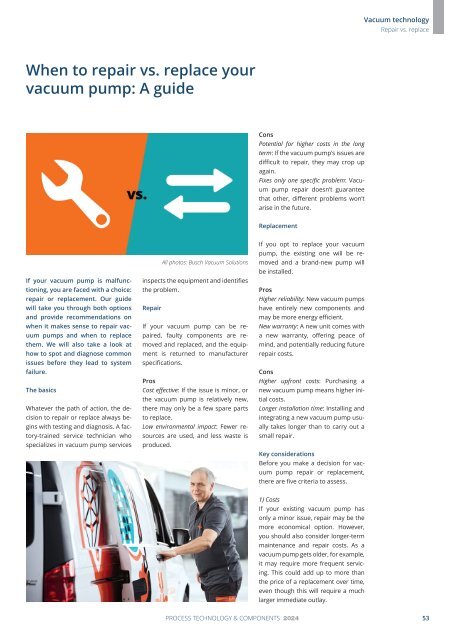PuK - Process Technology & Components 2024
A technical trade magazine with a history of more than 60 years.
A technical trade magazine with a history of more than 60 years.
You also want an ePaper? Increase the reach of your titles
YUMPU automatically turns print PDFs into web optimized ePapers that Google loves.
Vacuum technology<br />
Repair vs. replace<br />
When to repair vs. replace your<br />
vacuum pump: A guide<br />
Cons<br />
Potential for higher costs in the long<br />
term: If the vacuum pump’s issues are<br />
difficult to repair, they may crop up<br />
again.<br />
Fixes only one specific problem: Vacuum<br />
pump repair doesn’t guarantee<br />
that other, different problems won’t<br />
arise in the future.<br />
Replacement<br />
If your vacuum pump is malfunctioning,<br />
you are faced with a choice:<br />
repair or replacement. Our guide<br />
will take you through both options<br />
and provide recommendations on<br />
when it makes sense to repair vacuum<br />
pumps and when to replace<br />
them. We will also take a look at<br />
how to spot and diagnose common<br />
issues before they lead to system<br />
failure.<br />
The basics<br />
Whatever the path of action, the decision<br />
to repair or replace always begins<br />
with testing and diagnosis. A factory-trained<br />
service technician who<br />
specializes in vacuum pump services<br />
All photos: Busch Vacuum Solutions<br />
inspects the equipment and identifies<br />
the problem.<br />
Repair<br />
If your vacuum pump can be repaired,<br />
faulty components are removed<br />
and replaced, and the equipment<br />
is returned to manufacturer<br />
specifications.<br />
Pros<br />
Cost effective: If the issue is minor, or<br />
the vacuum pump is relatively new,<br />
there may only be a few spare parts<br />
to replace.<br />
Low environmental impact: Fewer resources<br />
are used, and less waste is<br />
produced.<br />
If you opt to replace your vacuum<br />
pump, the existing one will be removed<br />
and a brand-new pump will<br />
be installed.<br />
Pros<br />
Higher reliability: New vacuum pumps<br />
have entirely new components and<br />
may be more energy efficient.<br />
New warranty: A new unit comes with<br />
a new warranty, offering peace of<br />
mind, and potentially reducing future<br />
repair costs.<br />
Cons<br />
Higher upfront costs: Purchasing a<br />
new vacuum pump means higher initial<br />
costs.<br />
Longer installation time: Installing and<br />
integrating a new vacuum pump usually<br />
takes longer than to carry out a<br />
small repair.<br />
Key considerations<br />
Before you make a decision for vacuum<br />
pump repair or replacement,<br />
there are five criteria to assess.<br />
1) Costs<br />
If your existing vacuum pump has<br />
only a minor issue, repair may be the<br />
more economical option. How ever,<br />
you should also consider longer-term<br />
maintenance and repair costs. As a<br />
vacuum pump gets older, for example,<br />
it may require more frequent servicing.<br />
This could add up to more than<br />
the price of a replacement over time,<br />
even though this will require a much<br />
larger immediate outlay.<br />
PROCESS TECHNOLOGY & COMPONENTS <strong>2024</strong><br />
53

















